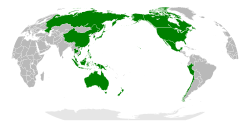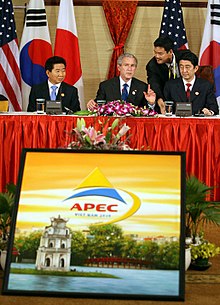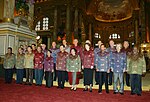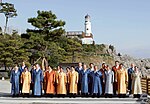Asia-Pacific Economic Cooperation: Difference between revisions
BIONICLE233 (talk | contribs) deleted red links |
BIONICLE233 (talk | contribs) fixed a red link to a blue link |
||
| Line 136: | Line 136: | ||
| 4th || September 10–11, 1992 || {{flag|Thailand}} || [[Bangkok]] || || || |
| 4th || September 10–11, 1992 || {{flag|Thailand}} || [[Bangkok]] || || || |
||
|- |
|- |
||
| 5th || November 19–20, 1993 || {{flag|United States}} || [[Seattle]] || [[Bomber |
| 5th || November 19–20, 1993 || {{flag|United States}} || [[Seattle]] || [[Bomber jacket|Bombardier Jackets]] || || |
||
|- |
|- |
||
| 6th || November 15, 1994 || {{flag|Indonesia}} || [[Bogor]] ||[[Batik]] Shirts|| || |
| 6th || November 15, 1994 || {{flag|Indonesia}} || [[Bogor]] ||[[Batik]] Shirts|| || |
||
Revision as of 20:26, 30 November 2009
The Asia-Pacific Economic Cooperation (APEC) | |
|---|---|
 APEC member countries shown in green | |
| Headquarters | Singapore |
| Type | Economic forum |
| Member countries | 21 |
| Leaders | |
• APEC Chair | |
• Executive Director | |
| Establishment | 1989 |
Website http://www.apec.org/ | |
Asia-Pacific Economic Cooperation (APEC) is a forum for 21 Pacific Rim countries (styled 'member economies') to cooperate on regional trade and investment liberalisation and facilitation. APEC's objective is to enhance economic growth and prosperity in the region and to strengthen the Asia-Pacific community. Members account for approximately 40% of the world's population, approximately 54% of world GDP and about 44% of world trade.[1]
An annual APEC Economic Leaders' Meeting, attended by the heads of government of all APEC members (with the exception of the Republic of China (ROC) which is represented under the name Chinese Taipei by a ministerial-level official. The location of the meeting rotates annually among the member economies, and a famous tradition involves the attending Leaders dressing in a national costume of the host member.
History
In January 1989, Australian Prime Minister Bob Hawke called for more effective economic cooperation across the Pacific Rim region. This led to the first meeting of APEC in the Australian capital Canberra in November, chaired by Australian Foreign Affairs Minister Gareth Evans. Attended by political ministers from twelve countries, the meeting concluded with commitments for future annual meetings in Singapore and South Korea.
The initial proposal was opposed by countries of the Association of Southeast Asian Nations (ASEAN) which instead proposed the East Asia Economic Caucus which would exclude non-Asian countries such as the United States, Canada, Australia and New Zealand. The plan was opposed and strongly criticised by Japan and the United States.
The first APEC Economic Leaders' Meeting occurred in 1993 when US president Bill Clinton, after discussions with Australian prime minister Paul Keating, invited the heads of government from member economies to a summit on Blake Island. He believed it would help bring the stalled Uruguay Round of trade talks on track. At the meeting, some leaders called for continued reduction of barriers to trade and investment, envisioning a community in the Asia-Pacific region that might promote prosperity through cooperation. The APEC Secretariat, based in Singapore, was established to coordinate the activities of the organisation.
During the meeting in 1994 in Bogor, Indonesia, APEC Leaders adopted the Bogor Goals that aim for free and open trade and investment in the Asia-Pacific by 2010 for industrialised economies and by 2020 for developing economies. In 1995, APEC established a business advisory body named the APEC Business Advisory Council (ABAC), composed of three business executives from each member economy.
Member economies

APEC currently has 21 members, including most countries with a coastline on the Pacific Ocean. By convention, APEC uses the term member economy to refer to one of its members.
| Member economy | Date of accession |
|---|---|
| 1989 | |
| 1989 | |
| 1989 | |
| 1989 | |
| 1989 | |
| 1989 | |
| 1989 | |
| 1989 | |
| 1989 | |
| 1989 | |
| 1989 | |
| 1989 | |
| 1991 | |
| 1991 | |
| 1991 | |
| 1993 | |
| 1993 | |
| 1994 | |
| 1998 | |
| 1998 | |
| 1998 |
India has requested membership in APEC, and received initial support from the United States, Japan[5] and Australia. Officials have decided not to allow India to join for various reasons.[6][7] However, the decision was made not to admit more members until 2010. Moreover, India does not border the Pacific which all members do. The Philippines trade negotiator was quoted as saying that there is concern that "Once the Indians come in, the (Asian) weighting would become heavier in this part of the world."[8]
In addition to India, Mongolia, Pakistan, Laos, Bangladesh, Colombia,[9] and Ecuador,[10] are among a dozen countries seeking membership in APEC by 2008. Colombia applied for APEC's membership as early as in 1995, but its bid was halted as the organization stopped accepting new members from 1993 to 1996,[11] and the moratorium was further prolonged to 2007 due to the 1997 Asian Financial Crisis. Colombia and Ecuador hope to become members in 2010. [12] Guam has also been actively seeking a separate membership, citing the example of Hong Kong, but the request is opposed by the United States, which currently represents Guam. APEC is one of the few international level organizations that Taiwan is allowed to join, albeit under the name Chinese Taipei.
APEC Business Advisory Council
The APEC Business Advisory Council (ABAC) was created by the APEC Economic Leaders in November 1995 with the aim of providing advice to the APEC Economic Leaders on ways to achieve the Bogor Goals and other specific business sector priorities, and to provide the business perspective on specific areas of cooperation.
Each economy nominates up to three members from the private sector to ABAC. These business leaders represent a wide range of industry sectors.
ABAC provides an annual report to APEC Economic Leaders containing recommendations to improve the business and investment environment in the Asia-Pacific region, and outlining business views about priority regional issues.
ABAC is also the only non-governmental organisation that is on the official agenda of the APEC Economic Leader’s Meeting.
Annual APEC Economic Leaders' Meetings
Since its formation in 1989, APEC has held annual meetings with representatives from all member economies. The first four annual meetings were attended by ministerial-level officials. Beginning in 1993, the annual meetings are named APEC Economic Leaders' Meetings and are attended by the heads of government from all member economies except Taiwan, which is represented by a ministerial-level official. The annual Leaders' Meetings are not called summits. The location of the meeting is rotated annually among the members. As a tradition, the leaders attending the meeting participate in a photo op in which they dress in a costume that reflects the culture of the host member.
| Date | Host member | Location | Photo op fashion | Photo | Web site | |
|---|---|---|---|---|---|---|
| 1st | November 6–7, 1989 | Canberra | ||||
| 2nd | July 29–31, 1990 | Singapore | ||||
| 3rd | November 12–14, 1991 | Seoul | ||||
| 4th | September 10–11, 1992 | Bangkok | ||||
| 5th | November 19–20, 1993 | Seattle | Bombardier Jackets | |||
| 6th | November 15, 1994 | Bogor | Batik Shirts | |||
| 7th | November 19, 1995 | Osaka | Business Suits | |||
| 8th | November 25, 1996 | Manila and Subic | Barong Shirts | [1] | ||
| 9th | November 24–25, 1997 | Vancouver | Leather Jackets | [2] | ||
| 10th | November 17–18, 1998 | Kuala Lumpur | Batik Shirts | [3] | ||
| 11th | September 12–13, 1999 | Auckland | Sailing Jackets | [4] | ||
| 12th | November 15–16, 2000 | Brunei | Kain Tenunan Shirts |  |
[5] | |
| 13th | October 20–21, 2001 | Shanghai | Tangzhuang |  |
||
| 14th | October 26–27, 2002 | Los Cabos | Guayabera Shirts (M); Huipíles (F) | |||
| 15th | October 20–21, 2003 | Bangkok | Brocade Shirts (M); Brocade Shawls (F) |  |
||
| 16th | November 20–21, 2004 | Santiago | Chamantos |  |
[6] | |
| 17th | November 18–19, 2005 | Busan | Hanboks |  |
||
| 18th | November 18–19, 2006 | Hanoi | Áo dài |  |
[7] | |
| 19th | September 8–9, 2007 | Sydney | Drizabones and Akubra Hats |  |
[8] | |
| 20th | November 22–23, 2008 | Lima | Ponchos |  |
[9] | |
| 21st | November 14–15, 2009 | Singapore | Peranakan-Inspired Designer Shirts | [10] | ||
| 22nd | November 2010 | Yokohama | ||||
| 23rd | November 2011 | Honolulu | flowered shirts and grass skirts | |||
| 24th | November 2012 | Vladivostok | www.apec2012.ru | |||
| 25th | November 2013 |
APEC Economic Leaders' Meeting developments
In 1997, the APEC meeting was held in Vancouver. Controversy arose after officers of the Royal Canadian Mounted Police used pepper spray against protesters. The protesters objected to the presence of autocratic leaders such as Indonesian president Suharto.[13][14][15][16][17][18]
At the 2001 Leaders' Meeting in Shanghai, APEC leaders pushed for a new round of trade negotiations and support for a program of trade capacity-building assistance, leading to the launch of the Doha Development Agenda a few weeks later. The meeting also endorsed the Shanghai Accord proposed by the United States, emphasising the implementation of open markets, structural reform, and capacity building. As part of the accord, the meeting committed to develop and implement APEC transparency standards, reduce trade transaction costs in the Asia-Pacific region by 5 percent over 5 years, and pursue trade liberalization policies relating to information technology goods and services.
In 2003, Jemaah Islamiah leader Riduan Isamuddin had planned to attack the APEC Leaders Meeting to be held in Bangkok in October. He was captured in the city of Ayutthaya, Thailand by Thai police on August 11, 2003, before he could finish planning the attack.[citation needed] Chile became the first South American nation to host the Leaders' Meeting in 2004. The agenda of that year was focused on terrorism and commerce, small and medium enterprise development, and contemplation of free trade agreements and regional trade agreements.
The 2005 Leaders' Meeting was held in Busan, South Korea. The meeting focused on the Doha round of World Trade Organization (WTO) negotiations, leading up to the WTO Ministerial Conference of 2005 held in Hong Kong in December. Weeks earlier, trade negotiations in Paris were held between several WTO members, including the United States and the European Union, centered on reducing agricultural trade barriers. APEC leaders at the summit urged the European Union to agree to reducing farm subsidies. Peaceful protests against APEC were staged in Busan, but the meeting schedule was not affected.
At the Leaders' Meeting held on November 19, 2006 in Hanoi, APEC leaders called for a new start to global free-trade negotiations while condemning terrorism and other threats to security. APEC also criticised North Korea for conducting a nuclear test and a missile test launch that year, urging the country to take "concrete and effective" steps toward nuclear disarmament. Concerns about nuclear proliferation in the region was discussed in addition to economic topics. The United States and Russia signed an agreement as part of Russia's bid to join the World Trade Organization.
The APEC Australia 2007 Leaders' Meeting was held in Sydney from 2-9 September 2007. The political leaders agreed to an "aspirational goal" of a 25% reduction of energy intensity correlative with economic development.[19] Extreme security measures including airborne sharpshooters and extensive steel-and-concrete barricades were deployed against anticipated protesters and potential terrorists. However, protest activities were peaceful and the security envelope was penetrated with ease by a spoof diplomatic motorcade manned by members of the Australian television program The Chaser, one of whom was dressed to resemble the Al-Qaeda leader Osama bin Laden.
APEC's Three Pillars
To meet the Bogor Goals, APEC carries out work in three main areas: 1. Trade and Investment Liberalisation 2. Business Facilitation 3. Economic and Technical Cooperation
APEC and Trade Liberalisation
When APEC was established in 1989 average trade barriers in the region stood at 16.9 percent, by 2004 they had been reduced to 5.5%.[20]
APEC's Business Facilitation Efforts
APEC has long been at the forefront of reform efforts in the area of business facilitation. Between 2002-2006 the costs of business transactions across the region was reduced by 6 percent, thanks to the APEC Trade Facilitation Action Plan (TFAPI). Between 2007 and 2010, APEC hopes to achieve an additional 5 percent reduction in business transaction costs. To this end, a new Trade Facilitation Action Plan has been endorsed. According to a 2008 research brief published by the World Bank as part of its Trade Costs and Facilitation Project, increasing transparency in the region's trading system is critical if APEC is to meet its Bogor Goal targets.[21]
Trans-Pacific Strategic Economic Partnership Agreement

The Trans-Pacific Strategic Economic Partnership Agreement (TPP), also known as the P4 agreement is not an APEC initiative and does not fall within the APEC agenda. It is a multilateral free trade agreement between the countries of Brunei, Chile, New Zealand and Singapore which was signed on 3 June 2005 and came into force on 28 May 2006.[22][23] On September 2008, the United States announced it was entering negotiations to join the group.[24]
The TPP was previously known as the Pacific Three Closer Economic Partnership (P3-CEP) with its negotiations first launched on the sidelines of the 2002 APEC Leaders' Meeting in Los Cabos, Mexico, by Chilean President Ricardo Lagos and Prime Ministers Goh Chok Tong of Singapore and Helen Clark of New Zealand. Brunei first took part as a full negotiating party in the fifth round of talks in April 2005.
Despite cultural and geographical differences, the four member countries share certain similar attributes: all are relatively small countries (no more than 16 million inhabitants) and are members of the Asia-Pacific Economic Cooperation (APEC).
The aim of the agreement is to eliminate 90 percent of all tariffs between member countries by 1 January 2006 and reduce all trade tariffs to zero by 2015. It is a comprehensive agreement covering all the mainstays of an FTA, including trade in goods, rules of origin, trade remedies, sanitary and phytosanitary measures, technical barriers to trade, trade in services, intellectual property, government procurement and competition policy.
The agreement has the potential to grow to include other nations as the agreement includes an accession clause. This was particularly apparent from the fact that negotiations originally included just three countries (Chile, New Zealand and Singapore) and that Brunei was subsequently included into the agreement. In February 2008 the United States agreed to enter into talks with the P4 members regarding liberalising trade in financial services [25] and in September 2008, the United States announced it had decided to enter negotiations into joining the group.[26]
On 23 September 2008, an official announcement was made from Washington D.C. that the United States was to begin negotiations with the P-4 countries ASAP, with the first round of talks scheduled for March 2009 with New Zealand Prime Minister Helen Clark stating "I think the value to New Zealand of the United States coming into a transpacific agreement as a partner would be of the same value as we would hope to get from a bilateral FTA. . . It's very, very big news." Although the outcome of the FTA could become largely dependent on the results of the 2008 United States Presidential election as it is believed the Democratic Party are less friendly towards free trade than their Republican counterparts, despite this, Helen Clark said "I believe that to Democrats, New Zealand offers very few problems because we are very keen on environment and labour agreements as part of an overall approach to an FTA".[27][28] In November 2008, Australia, Vietnam and Peru announced that they would also be joining the P4 trade bloc.[29][30]
Since the inauguration of Barack Obama, the anticipated March negotiations have been put on hold due to delays in the appointment of Ron Kirk as United States Trade Representative. The U.S. Senate confirmed Kirk as United States Trade Representative on 18 March 2009 with a vote of 92 in favor and 5 opposed and he was sworn in the same day. Kirk was formally sworn in by Joe Biden on 20 March 2009. "The [New Zealand] government is deeply disappointed" that the United States is postponing trade talks involving New Zealand that were scheduled to get underway at the end of the month, NZ Prime Minister John Key says and that "New Zealand will continue to advocate very strongly for a trade deal."[31]
Free Trade Area of the Asia-Pacific
APEC is considering the prospects and options for a Free Trade Area of the Asia-Pacific (FTAAP) which would include all member economies of Asia-Pacific Economic Cooperation (APEC). Since 2006, the APEC Business Advisory Council, promoting the theory that a free trade area has the best chance of converging the member nations and ensuring stable economic growth under free trade, has lobbied for the creation of a high-level task force to study and develop a plan for a free trade area. The proposal for a FTAAP arose due to the lack of progress in the Doha round of World Trade Organization negotiations, and as a way to overcome the 'spaghetti bowl' effect created by overlapping and conflicting elements of free trade agreements between members - there are as many as 60 free trade agreements and 117 being negotiated in Southeast Asia and the Asia-Pacific region.[32][32][33] [34][34] The FTAAP is more ambitious in scope than the Doha round, which limits itself to reducing trade restrictions. The FTAAP would create a free trade zone that would considerably expand commerce and economic growth in the most dynamic region in the world.[32][34] The economic expansion and growth in trade could exceed the expectations of other regional free trade areas such as the ASEAN Plus Three (ASEAN + China, Japan, and South Korea).[35] Some criticisms include that the diversion of trade within APEC members would create trade imbalances, market conflicts and complications with nations of other regions.[34] The development of the FTAAP is expected to take many years, involving essential studies, evaluations and negotiations between member economies.[32] It is also affected by the absence of political will and popular agitations and lobbying against free trade in domestic politics.[32]
APEC Study Center Consortium
In 1993, APEC Leaders decided to establish a network of APEC Study Centres (ASCs) amongst universities and research institutions in APEC member economies.[36]
Notable centers include:
- Australian APEC Study Centre, Royal Melbourne Institute of Technology, Australia[37]
- Berkeley APEC Study Center, University of California, Berkeley, United States[38]
- Chinese Taipei APEC Study Center, Taiwan Institute of Economic Research, Taiwan[39]
- HKU APEC Study Center, Hong Kong University, Hong Kong, China[40]
- Kobe APEC Study Center, Kobe University, Japan[41]
- Nankai APEC Study Center, Nankai University, People's Republic of China[42]
- The Canadian APEC Study Centre, The Asia Pacific Foundation of Canada, Vancouver, Canada[43]
Criticism
APEC has been criticized for failing to clearly define itself or serve a useful purpose. According to the organisation it is "the premier forum for facilitating economic growth, cooperation, trade and investment in the Asia-Pacific region" established to "further enhance economic growth and prosperity for the region and to strengthen the Asia-Pacific community."[44] However, whether it has accomplished anything constructive remains debatable.[45]
See also
- APEC Sydney Metropolitan Public Holiday 2007
- Asia-Europe Meeting
- ASEAN Free Trade Area
- East Asia Economic Caucus
- East Asia Summit
- PECC
- Asia-Pacific Trade Agreements Database
References
- ^ APEC Secretariat website
- ^ The Republic of China (ROC) is not allowed to use the name "Republic of China" or "Taiwan", but is instead referred to as Chinese Taipei within the organization as it is not a recognized member of the United Nations. The President of the Republic of China does not attend the annual APEC Economic Leaders' Meeting, instead sending a ministerial-level official responsible for economic affairs (See List of Chinese Taipei Representatives to APEC).
- ^ Hong Kong joined APEC in 1991 during British administration with the name "
 Hong Kong." In 1997, Hong Kong became a special administrative region of the People's Republic of China and took the name "Hong Kong, China."
Hong Kong." In 1997, Hong Kong became a special administrative region of the People's Republic of China and took the name "Hong Kong, China."
- ^ The People's Republic of China represents the interests of mainland China only, since Hong Kong and Macau are considered separate economies.
- ^ APEC 'too busy' for free trade deal, says Canberra
- ^ India's membership issue
- ^ Extend a hand to an absent friend
- ^ AFP: West worried India would tip APEC power balance: official
- ^ Peru, Colombia seek closer Central America, APEC trade ties - DominicanToday.com
- ^ People's Daily Online - Ecuador seeks APEC accession in 2007
- ^ People's Daily Online - Colombia seeks APEC membership in 2007: FM
- ^ India may not get Apec club membership-India Business-Business-The Times of India
- ^ Pue, W. Wesley (2000). Pepper in our Eyes: the APEC Affair. Vancouver, Canada: UBC Press. ISBN 0-7748-0779-2.
- ^ Wallace, Bruce (September 21, 1998). "APEC Protest Controversy". Maclean's via The Canadian Encyclopedia. Historica Foundation of Canada. Retrieved 2006-09-06.
- ^ Nuttall-Smith, Chris (November 27, 1997). "APEC summit gets nasty at UBC". Varsity News. Sarah Galashan. Varsity Publications, Inc. Retrieved 2006-09-06.
- ^ Schmidt, Sarah (January 6, 1998). "Student protesters fight back for civil rights". Varsity News. Varsity Publications, Inc. Retrieved 2006-09-06.
- ^ "Civil rights group denounces attack on UBC students' APEC protests" (Press release). British Columbia Civil Liberties Association (BCCLA). November 23, 1997. Retrieved 2006-09-06.
- ^ "Student member of BCCLA executive arrested!" (Press release). British Columbia Civil Liberties Association (BCCLA). November 25, 1997. Retrieved 2006-09-06.
- ^ "Apec supports nuclear, agrees climate targets". World Nuclear News. 2007-09-10. Retrieved 2007-09-15.
- ^ A Mid-Term Stocktake of the Bogor Goals, APEC 2005
- ^ "Transparency Reform Could Raise Trade by $148 Billion in APEC" John S. Wilson & Benjamin Taylor; Trade Facilitation Reform Research Brief, The World Bank. 2008.
- ^ Text of agreement
- ^ New Zealand Ministry of Foreign Affairs and Trade
- ^ United States to Join Sectoral Negotiations with Four Asia-Pacific Countries
- ^ "First step to wider free trade". New Zealand Herald. Retrieved 2008-02-09.
- ^ Oliver, Paula (23 September 2008). "US trade move big news for NZ: Clark". The New Zealand Herald.
- ^ http://www.nzherald.co.nz/politics/news/article.cfm?c_id=280&objectid=10533623&pnum=0
- ^ http://www.stuff.co.nz/4701726a6160.html
- ^ "Australia To Join Trans-Pacific Partnership Trade Bloc". Alibaba.com. Retrieved 2008-12-17.
- ^ "The challenges of regional bodies". Taipei Times. Retrieved 2008-12-17.
- ^ http://tvnz.co.nz/business-news/us-postpones-free-trade-talks-2524837
- ^ a b c d e FTAAP
- ^ APEC to consider free trade area
- ^ a b c d Plan B for World Trade
- ^ Policy Briefs in International Economics (PDF)
- ^ APEC Study Center Contortium
- ^ Australian APEC Study Centre
- ^ Berkeley APEC Study Center
- ^ Chinese Taipei APEC Study Center
- ^ HKU APEC Study Center
- ^ Kobe University APEC Study Center
- ^ APEC Study Center of Nankai University
- ^ The Canadian APEC Study Centre, The Asia Pacific Foundation of Canada
- ^ About APEC - Asia-Pacific Economic Cooperation
- ^ http://www.economist.com/displaystory.cfm?story_id=9788478
